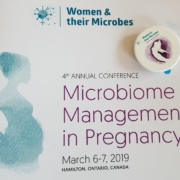Can Probiotics Cause Harm? The example of pregnancy
By Prof. Dan Merenstein MD, Georgetown University School of Medicine, Washington DC, USA and Dr. Maria Carmen Collado, Institute of Agrochemistry and Food Technology-National Research Council (IATA-CSIC), Valencia, Spain
Limiting excessive weight gain and controlling blood pressure during pregnancy are important to prevent pre-eclampsia and other complications of pregnancy. Researchers have examined if there is a role for probiotics in maintaining a healthy pregnancy. A recent Cochrane review, which evaluated evidence on probiotics for preventing gestational diabetes (GDM), concluded, “Low-certainty evidence from six trials has not clearly identified the effect of probiotics on the risk of GDM. However, high-certainty evidence suggests there is an increased risk of pre-eclampsia with probiotic administration.” This was an unexpected conclusion, which raised concerns about probiotic safety. A close look at the basis for this statement is warranted to determine if certain strains of probiotics are contraindicated for pregnant women.
Most people familiar with probiotic science understand that giving anyone live bacteria carries some risk. The definition of probiotics is live microorganisms that, when administered in adequate amounts, confer a health benefit on the host. It is not live microorganisms that, when administered in adequate amounts, confer a health benefit on the host that outweighs potential adverse events. But clinicians understand that risk versus benefit must be considered for all interventions.
Many interventions associated with significant positive outcomes also are associated with some adverse events, some quite significant. For example, a recent United States Preventive Services Task Force report found that beta carotene, with or without vitamin A, was significantly associated with an increased risk of lung cancer and cardiovascular disease mortality. Aspirin kills thousands of people each year, with many more hospitalized with significant bleeds. While for an exercise doctors recommend all the time, biking, the CDC reports nearly 1,000 bicyclists die and over 130,000 are injured in crashes every year in the US.
Studies that led to the Cochrane conclusion
But let’s get back to trying to understand what made the Cochrane review come out with this warning about probiotics and pre-eclampsia. Turns out the conclusion was based on four randomized clinical trials which reported pre-eclampsia as an adverse event. All four studies were well done with low risk of bias per the Cochrane report.
Here is a summary of the four studies that collected preeclampsia data, included in the Cochrane review:
Callaway et al.(2019) studied a mixture of Lactobacillus rhamnosus (LGG) and Bifidobacterium animalis subspecies lactis BB-12 for the prevention of gestational diabetes The reported pre-eclampsia in the probiotic group was 19 (9.2%) participants compared to 10 (4.9%) in the placebo group, p-value=0.09. This was in an obese cohort, with an average BMI of both groups near 32 (kg/m2).
Lindsay et al. (2014) evaluated the effect of Lactobacillus salivarius UCC118 on maternal fasting glucose. They reported preeclampsia in 3/62 in the probiotic group versus 2/74 in the placebo group (p-value >0.366). Again, this was in an obese cohort with early pregnancy BMIs in the probiotic group, averaging 32.9 versus 34.1 in the placebo group.
Pellonpera et al. (2019) conducted a 4-arm study to determine if fish oil and or Lactobacillus rhamnosus HN001 and Bifidobacterium animalis ssp. lactis 420 could prevent gestational diabetes. In total there were 10 cases of pre-eclampsia among the four groups as shown below, (each group had about 95 total participants) and no significant differences between them, p value=0.80.
- Fish oil + placebo, 1 of 95 participants (1.1%)
- Probiotics + placebo, 4 of 96 participants (4.2%)
- Fish oil + probiotics 3, of 96 participants (3.1%)
- Placebo + placebo, 2 of 93 participants (2.2%)
Okesene-Gafa et al. (2019) published in the American Journal of Obstetrics and Gynecology in 2019 looking at culturally tailored dietary intervention and or daily probiotic capsules containing lactobacillus rhamnosus GG and Bifidobacterium lactis BB12 impact pregnancy weight-gain and birthweight. (This was also an obese cohort with an average BMI of 38.8.) They found pregnancy induced hypertension in the probiotic group in 4/96 (4.2%) of women versus 2/93 (2.2%) in the placebo group (p value=0.31).
Is there a rationale for the preeclampsia warning?
The increased rate of preeclampsia in probiotic groups was only with studies using obese subjects. Importantly, obesity has been associated with a higher risk of preeclampsia (see here and here). A recent meta-analysis, which included 86 studies representing 20,328,777 pregnant women, showed that higher BMI is associated with adverse pregnancy outcomes, among them, gestational diabetes and preeclampsia. Furthermore, the adjusted risk of preeclampsia is estimated to be double for overweight mothers and almost triple for obese mothers, compared to normal weight mothers.
It has been reported that pro-inflammatory signals (TNF-alpha, IL6) produced in adipose tissue of obese individuals induces a proinflammatory state characterized by insulin resistance and altered endothelial function. The gut microbiota is also disrupted in these individuals, consistent with observations that report an altered gut microbiota composition in obese versus lean individuals (see here, and the effects on offspring here and here). This suggests that obese mothers may have an increased risk of adverse events, but still the evidence supports that the addition of certain strains of probiotics may exacerbate this risk. Furthermore, it is relevant to mention the accumulating data showing that during gestation in parallel to the physiological, immune and metabolic adaptations, gut microbiota changes over the pregnancy (see here, here, here and here) although little is known on the impact of pre-gestational BMI on gut microbiota changes during pregnancy. However, specific microbial shifts have been reported to be predictive of GDM and also, gut microbial differences in women with and without GDM have been reported (here and here) . It has been also reported that the gut microbiota shifts (in composition and activity metabolites) in women with preeclampsia (see here). Thus, it is quite possible that the women in these studies, obese women, react to gut-microbiota-related interventions differently than non-obese women and that their pre-pregnancy weight puts them at an increased risk of complications.
It is worth noting that the total number of cases cited in the Cochrane review supporting their conclusion was 31 cases of preeclampsia in 472 women who took probiotics versus 17 in 483 women in the placebo groups. Thus, 14 more women who experienced preeclampsia, 9 of whom came from one of the studies [“probiotics increase the risk of pre-eclampsia compared to placebo (RR 1.85, 95% CI 1.04 to 3.29; p-value=0.04; 4 studies, 955 women; high-certainty evidence”] This is not a very large number of subjects for such a strong conclusion. The authors don’t mention if this high-certainty evidence is in all women or just obese women. By combining four studies, in which none found a significant increase in preeclampsia, the authors did find significance. Is this a convincing number of subjects? The Cochrane author, Dr. Marloes Dekker Nitert replied to an inquiry from us that she believes that this difference makes it unethical to conduct further studies in pregnant women, stating, “I think that there now is a lack of clinical equipoise to do an RCT on a combination of Lactobacillus/Bifidobacterium.”
This is a strong statement but is consistent with their high-certainty of evidence statement. We acknowledge that something does appear to be going on. It is possible that certain populations react differentially to certain strains. Thus, maybe mild to morbidly obese women are a subgroup that needs closer monitoring during pregnancy and maybe even in non-pregnant settings, as they may react differently to probiotic interventions. Maybe it is just certain strains, as the Cochrane author was very clear in her email to state, “a combination of Lactobacillus/Bifidobacterium” and not generalize to all probiotics. We agree and in fact it is possible that different strains of Lactobacillus/Bifidobacterium will have different outcomes. Pregnancy is also a continuum and to think that giving an intervention during the first trimester is the same as during the third makes little scientific or clinical sense. Along these lines, one study showed the association of probiotic intake with different effects in early versus late pregnancy; an analysis that specifically focused on women in the third trimester of pregnancy found no association between probiotics and adverse fetal outcomes.
Conclusions
In summary, we must recognize that certain strains of probiotics may cause harm in certain populations. This reinforces the importance of diligent collection of adverse event data during all clinical trials. Although Cochrane is renowned to conduct analyses of the highest caliber, we wonder if four studies of 955 mostly obese women, in which 14 more in the probiotic group than the placebo group have a secondary outcome of harm, warrant the conclusion that there is “high-certainty evidence” that probiotics cause harm. This seems overstated based on our review of the literature. Should women and clinicians pay particular attention to this subgroup (obese pregnant women) and this outcome (preeclampsia, hypertension)? We think the answer is yes. But we do not conclude that all women at all stages of pregnancy need to refrain from probiotics. Fortunately, at the time of writing there appear to be 87 trials listed on clinicaltrials.gov looking at probiotics and pregnancy. As in many things the details still need to be further elucidated and we expect more clarification on this issue over the next 5-10 years.






